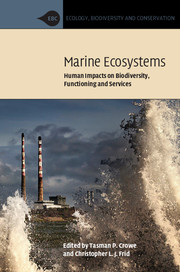Book contents
- Frontmatter
- Contents
- List of contributors
- Part I Key concepts
- 1 Introduction
- 2 Ecosystem services and benefits from marine ecosystems
- 3 Assessing human impacts on marine ecosystems
- 4 Modifiers of impacts on marine ecosystems: disturbance regimes, multiple stressors and receiving environments
- 5 Impacts of changing biodiversity on marine ecosystem functioning
- Part II Impacts of human activities and pressures
- Part III Synthesis and conclusions
- Index
- Plate Section
- References
4 - Modifiers of impacts on marine ecosystems: disturbance regimes, multiple stressors and receiving environments
from Part I - Key concepts
Published online by Cambridge University Press: 05 June 2015
- Frontmatter
- Contents
- List of contributors
- Part I Key concepts
- 1 Introduction
- 2 Ecosystem services and benefits from marine ecosystems
- 3 Assessing human impacts on marine ecosystems
- 4 Modifiers of impacts on marine ecosystems: disturbance regimes, multiple stressors and receiving environments
- 5 Impacts of changing biodiversity on marine ecosystem functioning
- Part II Impacts of human activities and pressures
- Part III Synthesis and conclusions
- Index
- Plate Section
- References
Summary
Introduction
Effective management and the maintenance of marine ecosystem services rely on a capacity to predict the ecological consequences of environmental change and potential management interventions (Chapter 1). Making these predictions is difficult because anthropogenic stressors do not produce uniform or consistent impacts on biodiversity and ecosystem functioning. Rather, their effects can be modified by a variety of factors that cause them to vary among locations and different points in time. Thus, the effectiveness of actions taken to manage environmental problems is likely to vary in a similar way: interventions that are sufficient to mitigate a stressor's impacts in one situation might be inadequate or excessive in others. Both sound science and efficient management require us to recognise that spatial and temporal variability are inherent to natural systems, and that the ecosystem complexity places inherent limits on our ability to predict future ecological conditions. However, many of the causes of this variability have been identified. Careful consideration of these factors will enhance scientific understanding, improve ecological prediction and enhance our efforts to optimise marine policy and management by reducing the uncertainty associated with the effects of stressors.
In this chapter, we examine three factors that cause anthropogenic activities to have inconsistent impacts on marine ecosystems. Both individual organisms and entire ecosystems tend to respond nonlinearly to gradients in stressor severity. Thus, we begin by discussing how differences in stressor intensity, as well as spatial and temporal characteristics of stressors' disturbance regimes can influence their impacts. Next, we discuss how characteristics of receiving ecosystems influence their sensitivity to stressors' impacts. These include biological characteristics such as the genetic structure of populations and community composition, as well as physical and chemical variables that may alter stressors' effects. Finally, we will discuss an issue of increasing concern among scientists and policy makers: the impacts of multiple stressors and the ways in which stressors can modify one another's effects.
- Type
- Chapter
- Information
- Marine EcosystemsHuman Impacts on Biodiversity, Functioning and Services, pp. 73 - 110Publisher: Cambridge University PressPrint publication year: 2015
References
- 9
- Cited by



